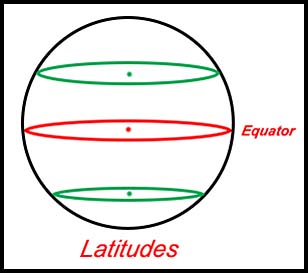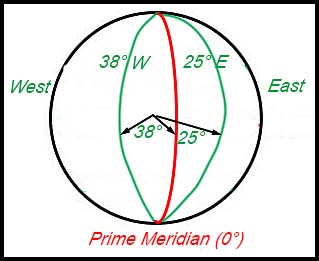Where the techniques of Maths
are explained in simple terms.
Longitudes and latitudes.
Some basic concepts.
- Algebra & Number
- Calculus
- Financial Maths
- Functions & Quadratics
- Geometry
- Measurement
- Networks & Graphs
- Probability & Statistics
- Trigonometry
- Maths & beyond
- Index
Earth is made up of a number of (approximate) circles. The two main types are:
Latitudes or horizontal circles.
| Horizontal circles can be drawn (or imagined) cutting through Earth anywhere from the top (the so-called North Pole in the Arctic region) to the bottom (the so-called South Pole in Antarctica). The Equator is the biggest (horizontal) circle. As we move away from the Equator and towards the Pole, the horizontal circles become smaller .
The horizontal circles are referred to as latitudes. The center of the smaller (horizontal) circles is NOT the centre of the sphere (i.e. of Earth) - except at the Equator. The radius of these horizontal circles or latitudes changes as the vertical distance above or below the circle forming the Equator changes. The circles above or below the Equator are referred to as small circles or as parallels of latitude. |
 |
To identify a particular latitude, we measure the angle between:
This measurement is just like angles of elevation and depression in trigonometry. When the circles approach the top or bottom of Earth, the angle they make to the Equator approaches 90°. To indicate if the latitude or small circle is above or below the Equator, we write N or S after the angle (as is shown in the diagram at the right). |
 |
Longitudes or (long) vertical circles.
| Vertical circles can be drawn (or imagined as being drawn) on the circumference of the sphere using the centre of Earth as the centre. These circles are therefore all the same size. These circles are referred to as longitudes. They can also be called great circles or meridians of longitude. We do not often use the whole circle but a semi-circle. The main semi-circle is that passing through Greenwich (near London). It is called the Prime Meridian and it is set at the longitude of 0°. |
 |
Latitudes are then measured in either direction up to 180° when the other major latitude is located - called the International Dateline. Given that criterion for the latitude measurements, identifying a particular latitude requires measuring the angle between:
To indicate if the longitude is to the east or to the west of the Prime Meridian, we write E or W after the angle (as is shown in the diagram at the right). |
|
When writing the coordinates of a location, the latitude is written before the longitude (so in alphabetical order)
and both are in the one set of brackets.
For example the location of Hall's Creek is (18°S, 127°E).